Estimated reading time: 28 minutes
In the 1800s, people had to be creative with their ingredients. Oftentimes, only a few basic staples were available, and they had to be stretched to feed big families. So when cooking, people focused on frugality and practicality, things every pioneer had to understand in order to get by.
In this list of vintage recipes from the 1800s, you’ll find hearty foods like pioneer potato cakes and corn dodgers, comfort foods such as Indian pudding and Sally Lunn bread, and old-world treats like shoofly pie and figgy pudding. They'll give you a tasty glimpse into what kitchens were like in the past, when tradition met resourcefulness.
Want to save this post for later? Click Here to Pin It On Pinterest!
Table of Contents
Abraham Lincoln’s Chicken Fricassee Recipe
Abraham Lincoln’s Chicken Fricassee is a rich, creamy stew made with tender chicken simmered in seasoned milk or cream, then finished with a simple roux-based sauce.
This dish was a favorite of President Lincoln and often served by his stepmother, Sarah Bush Lincoln, and it's a good example of the simple yet hearty frontier cooking of 1800s America.
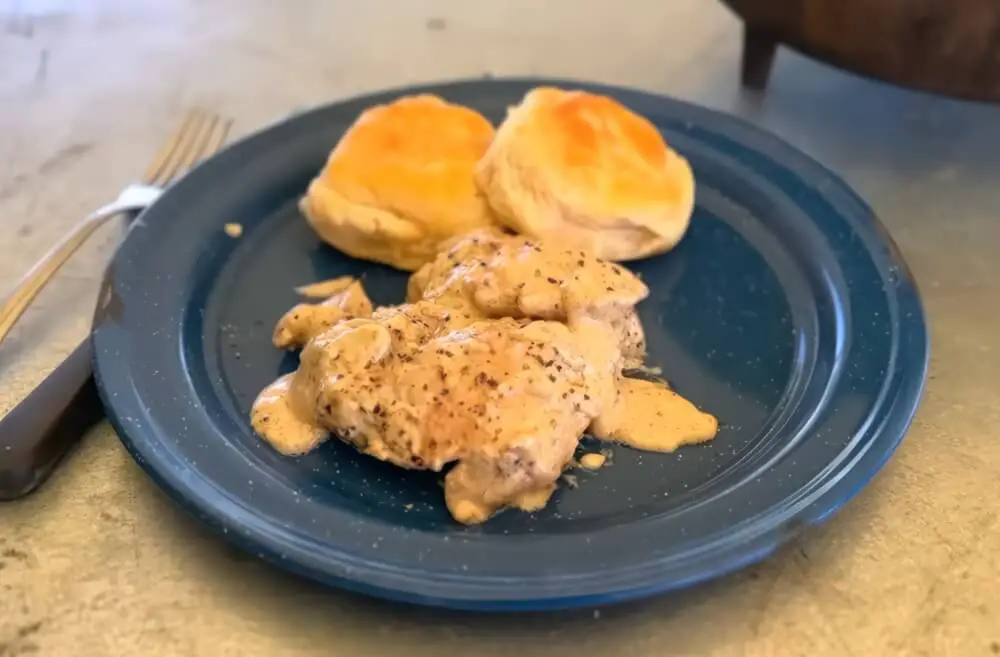
Prep Time: 15 minutes
Cook Time: 30–40 minutes
Servings: 6–8
Ingredients
- 1 whole chicken (3 to 4 lb.), cut into 8 pieces, skin removed
- ½ teaspoon salt
- ½ teaspoon freshly ground black pepper
- ½ teaspoon freshly grated nutmeg
- ¼ teaspoon ground mace
- 2 teaspoons fresh marjoram (or ½ teaspoon dried)
- 1½ cups cream, half-and-half, or milk
- 3 tablespoons butter
- 3 tablespoons all-purpose flour
- ¼ cup thinly sliced ham (optional)
Instructions
- Prepare the Chicken: If using a whole chicken, cut it into 8 similar-sized pieces and remove the skin.
- Season: In a small bowl, combine the salt, pepper, nutmeg, mace, and marjoram. Rub this seasoning mixture evenly over the chicken pieces.
- Cook the Chicken: Place the seasoned chicken pieces in a large skillet with a lid. Pour the cream (or milk) over the chicken, turning the pieces to coat them thoroughly.
- Simmer: Heat the skillet over medium heat until the liquid begins to bubble. Reduce the heat to low, cover the skillet, and simmer until the chicken is fork-tender, about 30 minutes. Remove the chicken pieces to a platter and keep warm.
- Make the Sauce: In a separate small bowl, combine the butter and flour to form a paste. Gradually whisk this paste into the remaining liquid in the skillet. Cook and stir over medium heat until the sauce thickens.
- Finish: Return the chicken to the skillet, spooning the sauce over the pieces to coat them. Reheat gently until the chicken is warmed through.
- Serve: Arrange the chicken on a serving platter. If desired, place thinly sliced ham around the edges of the platter. Serve hot, accompanied by biscuits, as Abraham Lincoln enjoyed.
Inspired by a recipe shared on 31 Daily
Alabama Lane Cake
Lane Cake is a classic Southern dessert with rich layers of white sponge cake filled with a bourbon-infused custard. It was created in Alabama in the late 1800s by Emma Rylander Lane and got very poular after winning first prize at a Georgia county fair.
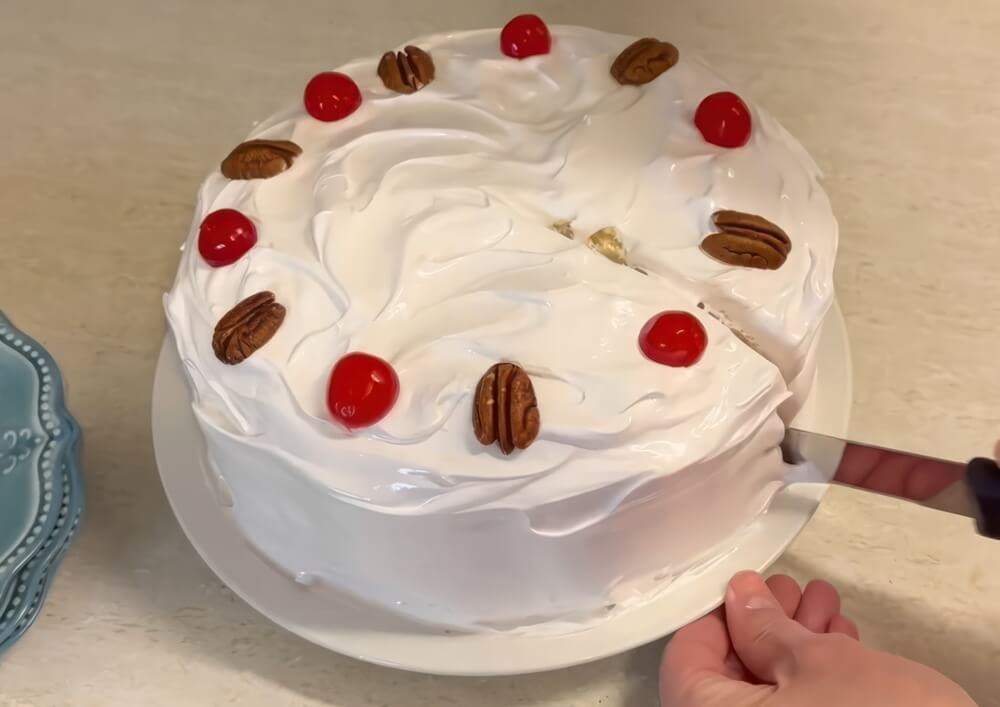
Prep Time: Approximately 1 hour
Cook Time: 30–35 minutes
Servings: 12–16
Ingredients
For the Cake:
- 3½ cups cake flour
- 1 tablespoon baking powder
- ½ teaspoon salt
- 1 cup unsalted butter, cold and cubed
- 2 cups granulated sugar
- 1 cup whole milk, at room temperature
- 1 teaspoon vanilla extract
- 8 large egg whites, at room temperature
For the Filling
- 8 large egg yolks
- 1 whole egg
- 2 cups granulated sugar
- ½ cup unsalted butter, softened
- ¼ cup whole milk
- 1 teaspoon vanilla extract
- ½ cup bourbon
- 1 cup golden raisins
- 2 cups chopped pecans
- 1 cup sweetened shredded coconut
- 10 maraschino cherries, halved (optional)
Instructions
Prepare the Cake:
- Preheat oven to 350°F.
- Grease three 8-inch round cake pans, line the bottoms with parchment paper, and grease the paper.
- In a large bowl, sift together the cake flour, baking powder, and salt.
- Using an electric mixer on low speed, combine the dry ingredients for about 20 seconds.
- Add the cold, cubed butter to the dry ingredients, mixing on low until the mixture resembles fine crumbs.
- In a separate bowl, mix the milk and vanilla extract.
- Gradually add the milk mixture to the flour mixture, mixing until just combined.
- In a clean bowl, beat the egg whites until stiff peaks form.
- Gently fold the beaten egg whites into the batter until fully incorporated.
- Divide the batter evenly among the prepared pans and smooth the tops.
- Bake for 30–35 minutes, or until a toothpick inserted into the center comes out clean.
- Allow the cakes to cool in the pans for 10 minutes, then turn them out onto wire racks to cool completely.
Prepare the Filling:
- In a medium saucepan, whisk together the egg yolks, whole egg, and sugar until well combined.
- Add the softened butter and milk to the mixture.
- Cook over medium heat, stirring constantly, until the mixture thickens and reaches a custard-like consistency.
- Remove from heat and stir in the vanilla extract and bourbon.
- Fold in the golden raisins, chopped pecans, shredded coconut, and maraschino cherries (if using).
- Allow the filling to cool to room temperature.
Assemble the Cake:
- Place one cake layer on a serving plate.
- Spread a generous amount of the filling over the top.
- Repeat with the remaining layers, ending with the filling on top.
- Optionally, frost the sides of the cake with a light, fluffy frosting, such as 7-minute frosting.
- Allow the cake to set for several hours or overnight to let the flavors meld.
Inspired by a recipe shared on All Recipes.
Apple Pandowdy
Apple pandowdy is a rustic 19th-century dessert made with spiced apples baked under a flaky crust, which is broken and pressed into the fruit partway through baking to soak up the juices. It was popular with early American settlers and it was a practical way to enjoy seasonal fruit with minimal fuss.

Yield: 8 servings
Prep Time: 30 minutes
Cook Time: 1 hour
Total Time: 1 hour 30 minutes
Ingredients
For the Flaky Pie Crust:
- 1¼ cups all-purpose flour
- ¾ teaspoon salt
- 2 tablespoons cold butter, cut into small pieces
- 4 tablespoons cold lard
- 2 tablespoons cold vegetable shortening
- 3 to 4 tablespoons ice water, divided
For the Filling:
- 2½ pounds baking apples (e.g., Cortland, Granny Smith, or Jonathan)
- 1 tablespoon fresh lemon juice
- ½ teaspoon ground cinnamon
- ¼ teaspoon freshly ground black pepper
- Pinch or two of ground cloves
- 1 tablespoon all-purpose flour
- ⅓ cup real maple syrup
- 3 tablespoons finely minced salt pork
- Heavy cream, for serving
- Maple syrup, for serving
Instructions
Prepare the Crust:
- In a food processor, combine flour and salt; pulse to mix.
- Add cold butter; pulse a few times.
- Add lard; pulse a few times.
- Add shortening; pulse a few times.
- Add 2 tablespoons of ice water; pulse until the dough just starts to hold together.
- Transfer to a lightly floured surface; add remaining water as needed, mixing by hand until the dough comes together.
- Flatten into a disk, wrap in plastic, and refrigerate for at least 30 minutes.
Prepare the Filling:
- Preheat oven to 400°F.
- Butter a 9×9-inch baking pan.
- Peel, core, and slice apples into thick slices, tossing with lemon juice to prevent browning.
- Add cinnamon, black pepper, cloves, and flour; toss to combine.
- Pour apples into the prepared pan; drizzle with maple syrup.
- Sprinkle minced salt pork over the top.
Assemble the Pandowdy:
- On a floured surface, roll out the chilled dough into a 10×10-inch square.
- Place the dough over the apples, pressing the edges down into the pan.
- Bake for 45 minutes.
- Remove from oven; use a spoon to break the crust and push some pieces down into the filling.
- Return to oven and bake for an additional 15 minutes.
Serve:
- While the pandowdy is baking, mix a little maple syrup into heavy cream to sweeten it.
- Serve the warm pandowdy with a drizzle of the sweetened cream.
Inspired by a recipe shared on A Family Feast.
Corn Dodgers
Corn dodgers are small, fried cornbread-like cakes that originated in the early 1800s. They were a staple for pioneers and soldiers since they were easy to make and portable, and they were an energy-rich snack during tough times.
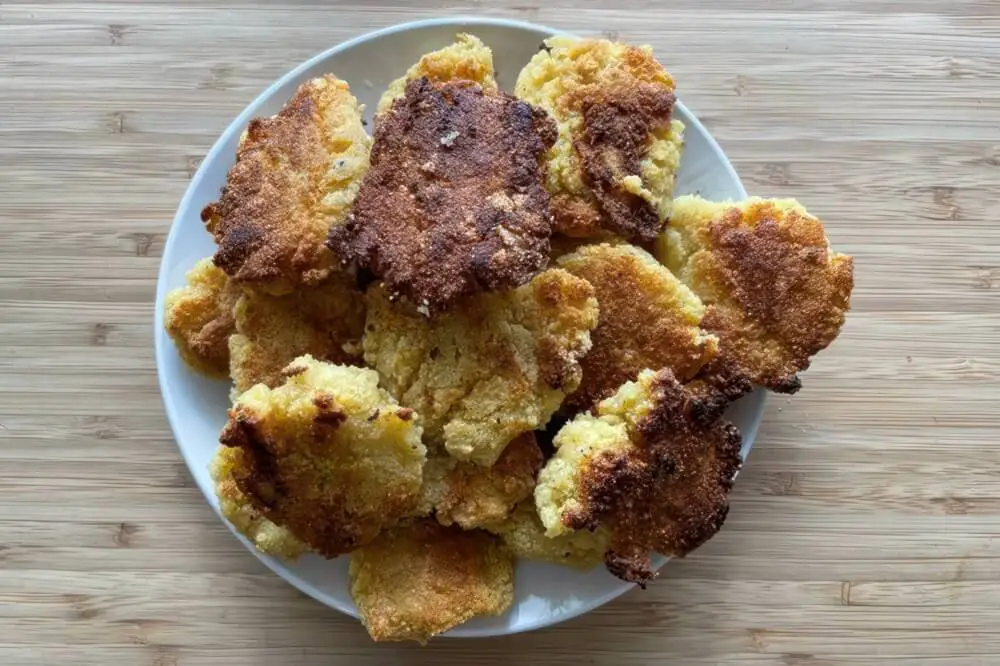
Ingredients:
- 2 cups cornmeal
- 2 tablespoons coconut oil (plus more for frying)
- ½ teaspoon salt
- 2 tablespoons brown sugar
- 2 cups milk
- 1 teaspoon baking powder
Instructions:
- Heat the Milk: In a cast iron pot over medium heat, slowly heat the milk and salt until just before boiling, stirring gently.
- Add Dry Ingredients: Reduce the heat and gradually add the cornmeal and brown sugar, stirring continuously until the mixture thickens.
- Incorporate Baking Powder: Remove the pot from heat and quickly stir in the baking powder.
- Rest the Dough: Let the dough rest for about 5 minutes.
- Prepare for Frying: Heat coconut oil in a skillet over medium heat.
- Fry the Dodgers: Drop spoonfuls of the dough into the hot oil, forming small pancakes. Fry each side for about 10 minutes, or until golden brown and crispy on the outside.
- Serve: Serve hot, optionally with butter, jam, honey, or as a side to soups and stews.
You can view pictures of the process here.
Cornpone
Cornpone is a simple, hearty bread made from cornmeal, traditionally baked or fried. It was a staple for pioneers and Civil War soldiers because it was easy to make and only took a few ingredients.
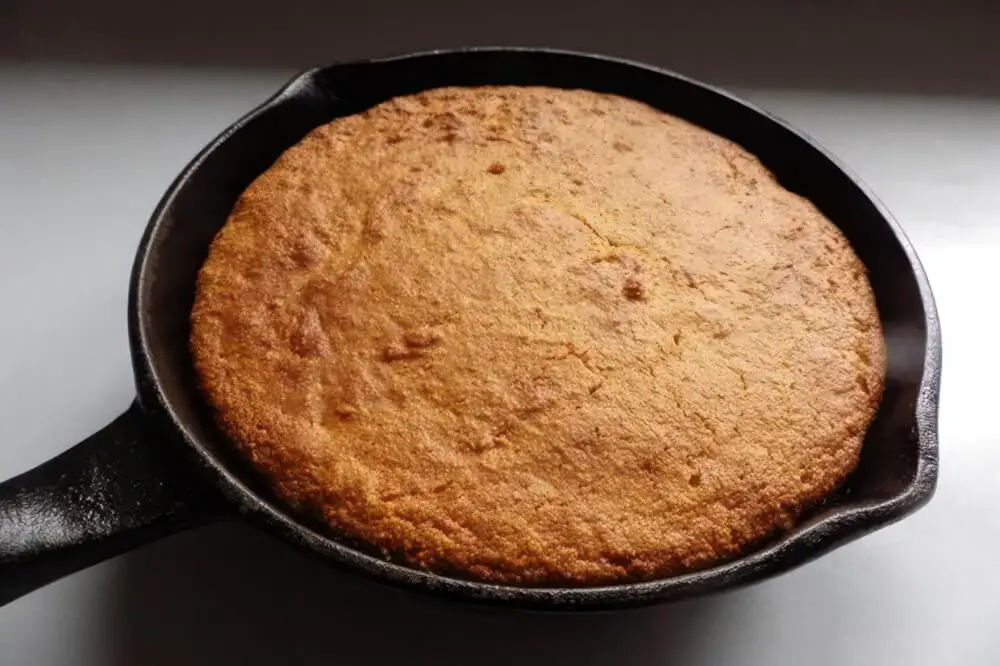
Ingredients:
- 3 cups cornmeal
- 4 cups boiling water
- 1¼ cups white sugar (or substitute with honey or maple syrup)
- 1 teaspoon salt
- 2 cups milk (room temperature)
- 3 eggs (room temperature)
- ½ cup melted butter
Instructions
- Preheat oven to 375°F.
- Prepare Baking Dish: Butter a Pyrex glass bread pan or a 9×13-inch baking pan.
- Mix Cornmeal and Water: Place the cornmeal in a large bowl. Pour in the boiling water and stir constantly until well blended.
- Add Sugar and Salt: Mix in the sugar and salt using an electric mixer until combined.
- Combine Milk and Eggs: In a separate bowl, beat the milk and eggs together. Slowly drizzle this mixture into the cornmeal, mixing and blending constantly.
- Add Butter: Pour in the melted butter and blend well.
- Bake: Pour the batter into the prepared pan. Bake in the preheated oven until the top is slightly browned, about 1 hour.
- Check for Doneness: Insert a toothpick into the center; if it comes out wet, bake for another 10 minutes. If dry, it's done.
- Serve: Slice and serve warm.
You can view pictures of the process here.
Figgy Pudding
Figgy pudding is a classic British holiday dessert made with dried figs, suet, breadcrumbs, and warm spices, all steamed into a rich, dense cake. It was often served during Christmas with a warm sauce or a splash of brandy that was set on fire. The alcohol burned off quickly and left behind a caramelized flavor.
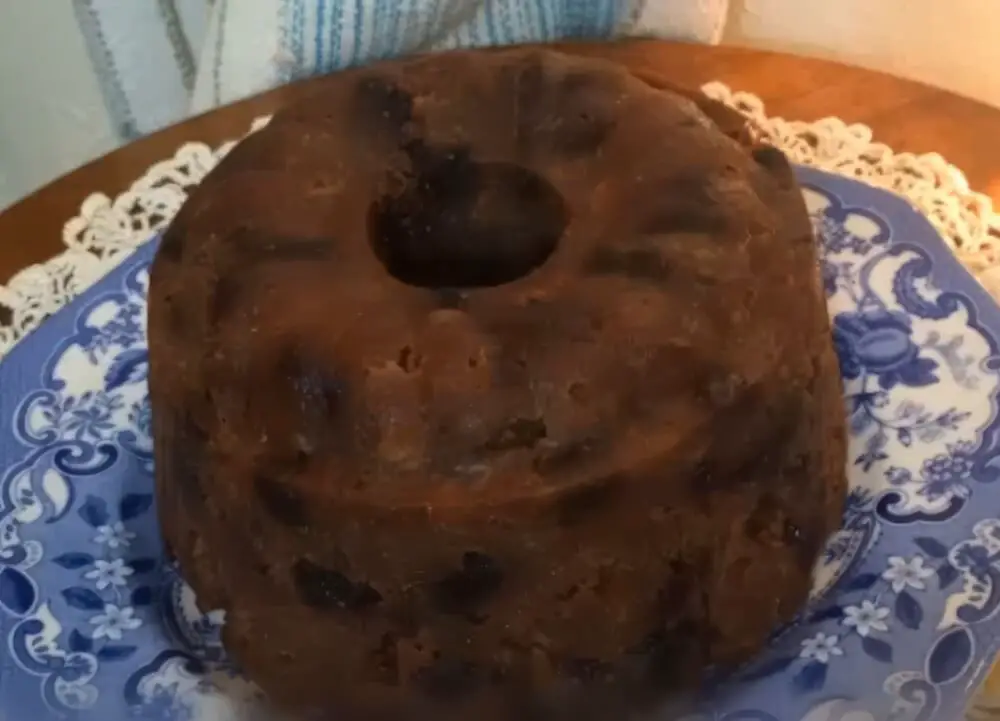
Prep Time: 15 minutes
Cook Time: 4 hours (boiled)
Serves: 6–8
Ingredients
- ½ lb. fresh breadcrumbs
- ½ lb. dried figs, chopped finely
- 6 oz. brown sugar
- 2 oz. all-purpose flour
- ¼ lb. suet (or substitute with cold butter or vegetable shortening), chopped finely
- 2 eggs, beaten
- Nutmeg, to taste
- A little milk (just enough to moisten the mixture)
Instructions
- In a large mixing bowl, combine the finely chopped figs and suet with the breadcrumbs, flour, sugar, and nutmeg.
- Add the beaten eggs and just enough milk to bring the mixture together into a moist, but not wet, consistency.
- Press the mixture firmly into a well-buttered pudding mold.
- Cover tightly with a thick cloth or foil, tying securely with kitchen twine.
- Boil the pudding (in the mold) for 4 hours, making sure to check water levels occasionally.
- Carefully remove the pudding from the mold and serve warm, with or without wine sauce.
Inspired by a recipe shared on The Cup That Cheers
Hardtack
Hardtack is a simple, long-lasting biscuit made from just flour and water. It was commonly used during the Civil War and by pioneers since it was easy to make and had an incredibly long shelf life.
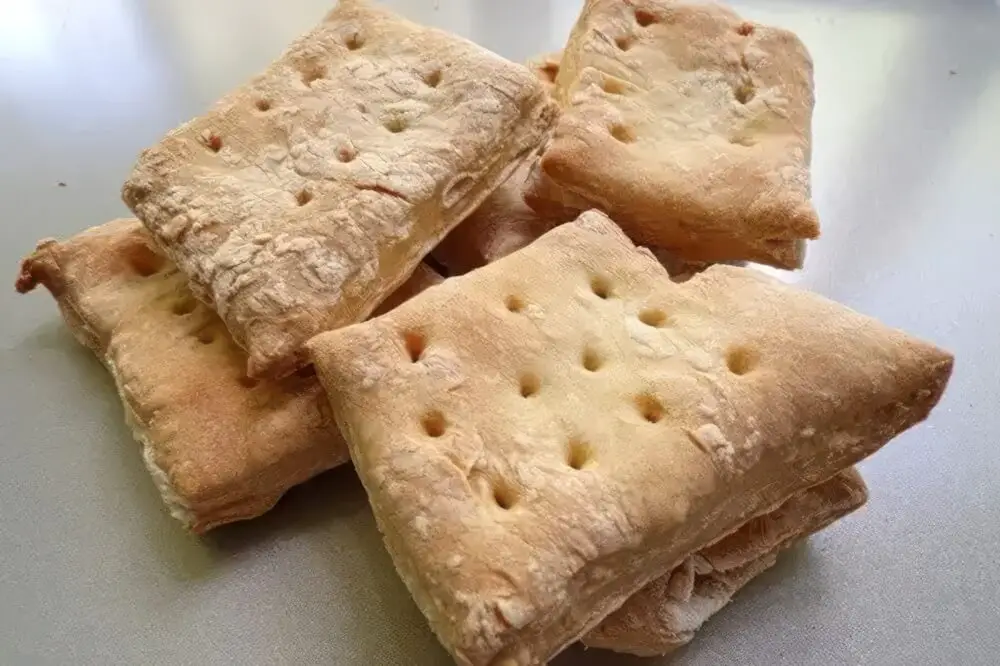
Ingredients
- 5 to 6 cups all-purpose flour
- 1 cup water
- Optional: ½ to 1 teaspoon salt (for flavor)
Instructions
- Preheat oven to 375°F.
- Mix Dough: In a mixing bowl, pour in the water. Gradually add flour (and salt, if using) until a stiff dough forms that is difficult to stir.
- Knead Dough: Once the dough becomes too stiff to stir, knead it by hand until it forms a cohesive ball.
- Roll Out Dough: Lightly flour your work surface. Place the dough in the center and use a rolling pin to roll it out into a rectangle approximately ½ inch thick.
- Cut into Squares: Use a pizza cutter or knife to cut the dough into squares about the size of saltine crackers.
- Poke Holes: Transfer the squares onto an ungreased cookie sheet. Use a skewer or fork to poke holes through each square to allow for even cooking.
- Bake: Place the cookie sheet in the preheated oven and bake for 30 minutes. Remove the sheet, flip each piece of hardtack, and bake for an additional 30 minutes.
- Cool and Dry: Remove the hardtack from the oven and allow it to cool completely. For extended shelf life, you can bake it for an additional 30 minutes at 250°F to ensure all moisture is removed.
You can view pictures of the process here.
Hasty Pudding
Hasty pudding is a simple dish made from cornmeal slowly cooked in milk or water until thick and porridge-like, then sweetened with molasses. It was popular in 1800s America, especially in New England, and it made a great dessert for pioneer and rural families.
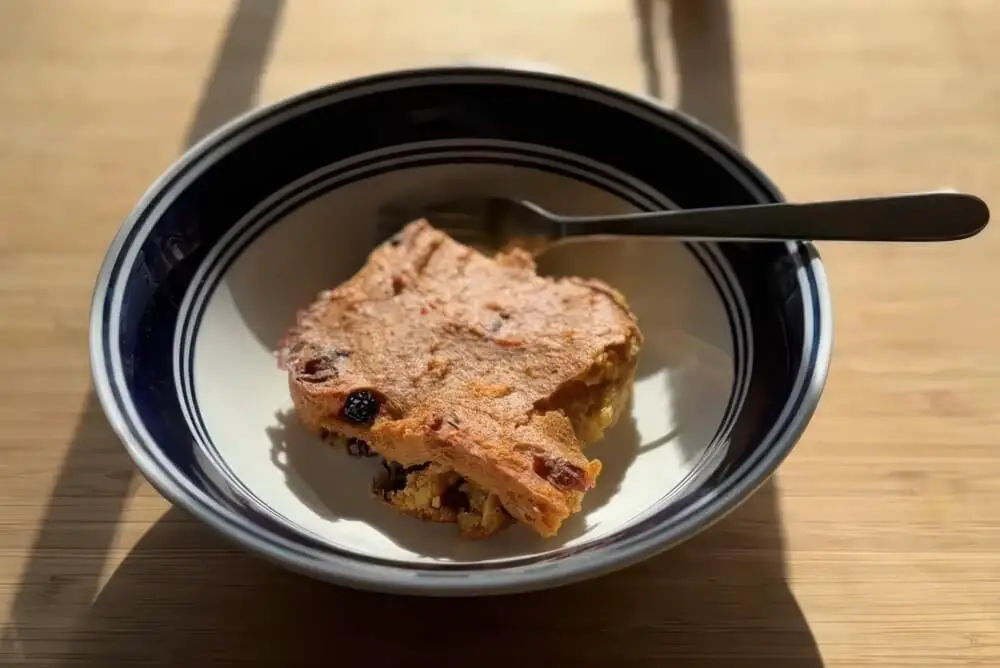
Prep Time: 15 minutes
Cook Time: 45 minutes
Total Time: 1 hour
Yield: Serves 6–8
Ingredients
- 4 large eggs
- 4 cups whole milk (for a creamier texture, substitute 2 cups with half and half)
- ½ cup granulated sugar
- ⅓ to ½ cup molasses (adjust to taste)
- ½ teaspoon pwdered ginger
- ¼ teaspoon nutmeg
- ½ teaspoon salt
- 1 cup fine cornmeal (for a smoother texture)
- 1 teaspoon vanilla extract
- Optional mix-ins: dried fruit, nuts
- Optional toppings: whipped cream, ice cream, or maple syrup
Instructions
- Preheat oven to 350°F.
- Prepare the Dish: Butter a 2-quart casserole dish. Optionally, place the casserole dish into a water bath for baking.
- Prepare Eggs: Crack all four eggs into a bowl and whisk well. Set aside.
- Heat Milk Mixture: In a large saucepan over medium heat, combine the milk (and half and half if using), sugar, molasses, ginger, nutmeg, and salt. Stir constantly and bring the mixture to the scalding point (just below simmering).
- Add Cornmeal: Slowly whisk the cornmeal into the hot milk mixture. Continue stirring until fully incorporated. Cook for 2 minutes, stirring continuously.
- Temper Eggs: To prevent the eggs from scrambling, slowly pour about half a cup of the hot mixture into the beaten eggs, whisking constantly to temper them. Then, pour the tempered eggs back into the saucepan, stirring continuously.
- Cook Pudding: Reduce the heat and cook the mixture for an additional 3 minutes, whisking the entire time. The mixture will thicken and bubble. Scrape down the sides and bottom frequently to prevent burning.
- Add Vanilla and Mix-ins: Remove the saucepan from heat. Stir in the vanilla extract and any optional mix-ins like dried fruit or nuts.
- Bake: Pour the mixture into the prepared casserole dish. Bake in the preheated oven for 45 minutes, or until the pudding is set and the top is golden brown.
- Cool and Serve: Allow the pudding to cool for at least 10 minutes before serving. Top with whipped cream, ice cream, or a drizzle of maple syrup if desired.
You can view pictures of the process here.
Indian Pudding
Indian pudding is a traditional New England dessert dating back to colonial America. It was made from cornmeal, molasses, and spices slowly baked into a rich, custard-like dish. It evolved from British hasty pudding but was adapted using “Indian meal” (cornmeal).
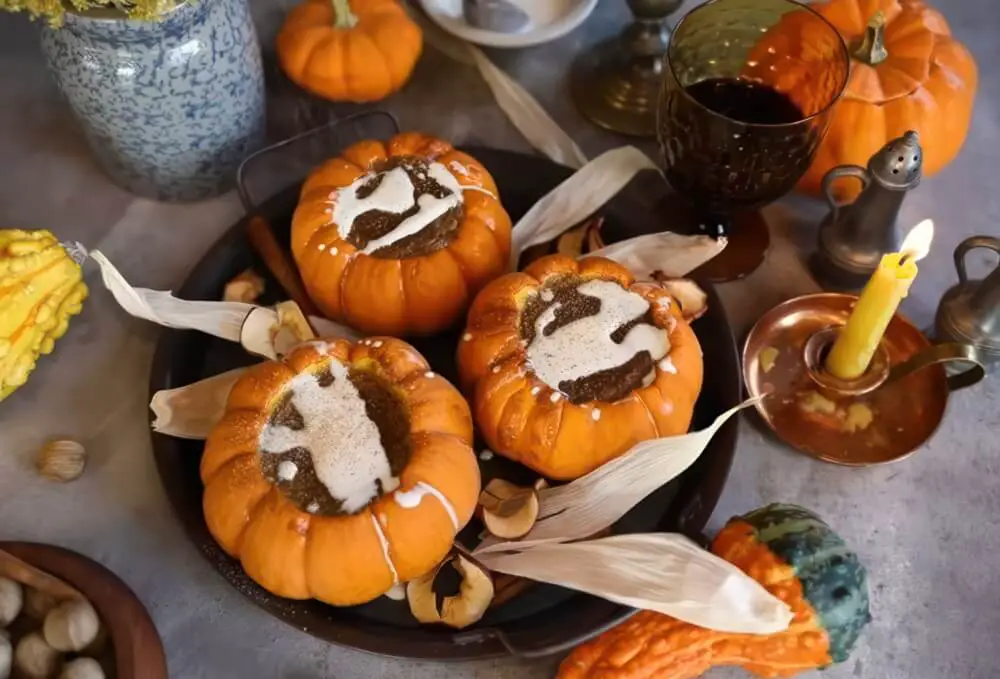
Prep Time: 30 minutes
Cook Time: 2 hours 30 minutes
Total Time: 3 hours
Yield: 8 servings
Ingredients
- 8 small pumpkins (about 1 cup capacity each), tops, seeds, and strings removed
- 1 cup (122 g) yellow cornmeal
- ½ cup (120 ml) water
- ¼ teaspoon kosher salt
- 2 cups (480 ml) milk
- ¼ cup (60 ml) molasses, plus more to taste
- 3 large eggs, beaten
- ½ cup (116 g) chopped suet or butter
- Optional: currants, raisins, or grated lemon peel
- Heavy cream, for serving
- Grated nutmeg, for serving
Instructions
- Preheat oven to 250°F. Arrange the hollowed pumpkins on a large baking sheet and set aside.
- Prepare Cornmeal Mush: In a large saucepan, combine the cornmeal, water, and salt. Cook over medium heat, stirring constantly, until the mixture thickens and the water is absorbed (about 5–7 minutes). Remove from heat and let cool slightly for about 10 minutes.
- Scald Milk: In a separate saucepan, heat the milk until just hot to the touch (scalding).
- Combine Ingredients: Pour the scalded milk over the cooled cornmeal mush. Stir in the molasses, beaten eggs, and suet or butter. If using, add currants, raisins, or grated lemon peel.
- Fill Pumpkins: Spoon the mixture into the prepared pumpkins. Alternatively, pour into a greased 9×9-inch baking pan.
- Bake: Place the filled pumpkins (or baking pan) in the preheated oven and bake for about 2 hours and 30 minutes, or until the pudding is set around the edges and slightly jiggly in the center.
- Cool and Serve: Remove from the oven and let cool for at least 1 hour. Serve at room temperature or chilled, topped with heavy cream and a sprinkle of grated nutmeg.
Inspired by a recipe shared on Under A Tin Roof
Native American Fry Bread
Native American fry bread is a hearty flatbread with deep cultural roots. Originally created from government-issued rations during the 19th century, it became a symbol of resilience and adaptation among Native Americans.
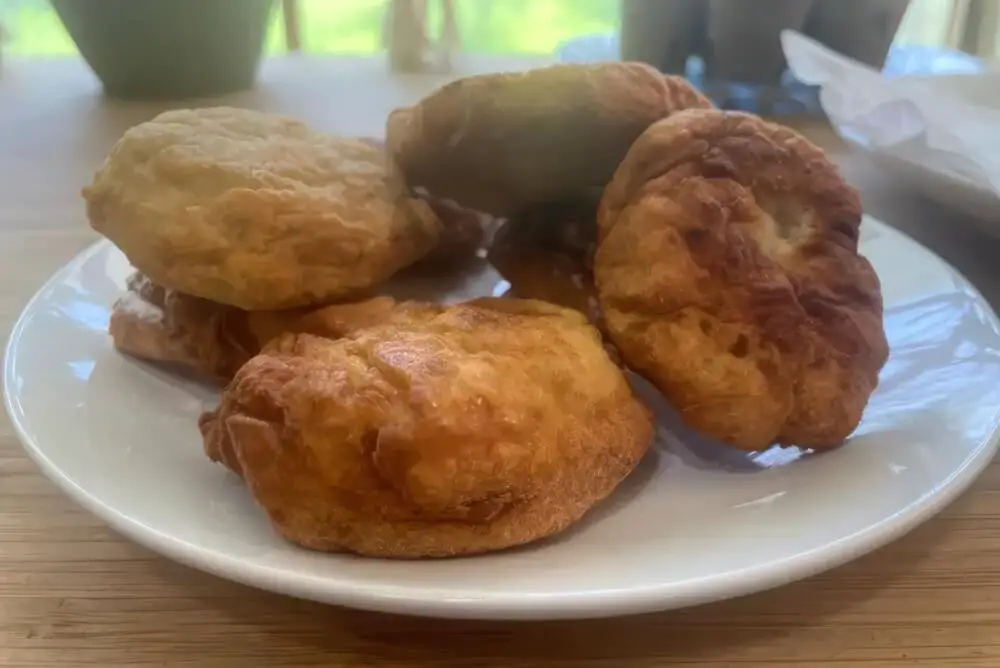
Prep Time: 15 minutes
Cook Time: 2–4 minutes per piece
Yield: Approximately 12 pieces
Ingredients
- 2 cups all-purpose flour
- ½ teaspoon salt
- 1 cup milk (any kind)
- Vegetable oil, lard, or shortening (for frying)
Instructions
- Heat the Oil: Pour about 2 inches of oil into a cast-iron skillet or deep frying pan. Heat over medium heat until the oil is hot but not smoking.
- Prepare the Dough: In a mixing bowl, combine the flour and salt. Gradually add the milk, stirring until a soft dough forms.
- Knead the Dough: Lightly flour a clean surface and knead the dough gently 3–4 times until smooth. Avoid overworking the dough to keep it tender.
- Divide and Shape: Divide the dough into 12 equal pieces. Flatten each piece into a disk about ¼ to ½ inch thick, creating a slight depression in the center.
- Fry the Bread: Carefully place a piece of dough into the hot oil. Fry for 1–2 minutes on each side, or until golden brown. Remove with a slotted spoon and drain on paper towels. Repeat with the remaining dough.
- Serve: Enjoy warm. Serve with sweet toppings like honey or powdered sugar, or use as a base for savory dishes like tacos.
You can view pictures of the process here.
Pemmican
Pemmican, a traditional Native American food, is renowned for its high energy content and long shelf life, making it an excellent choice for survival situations.
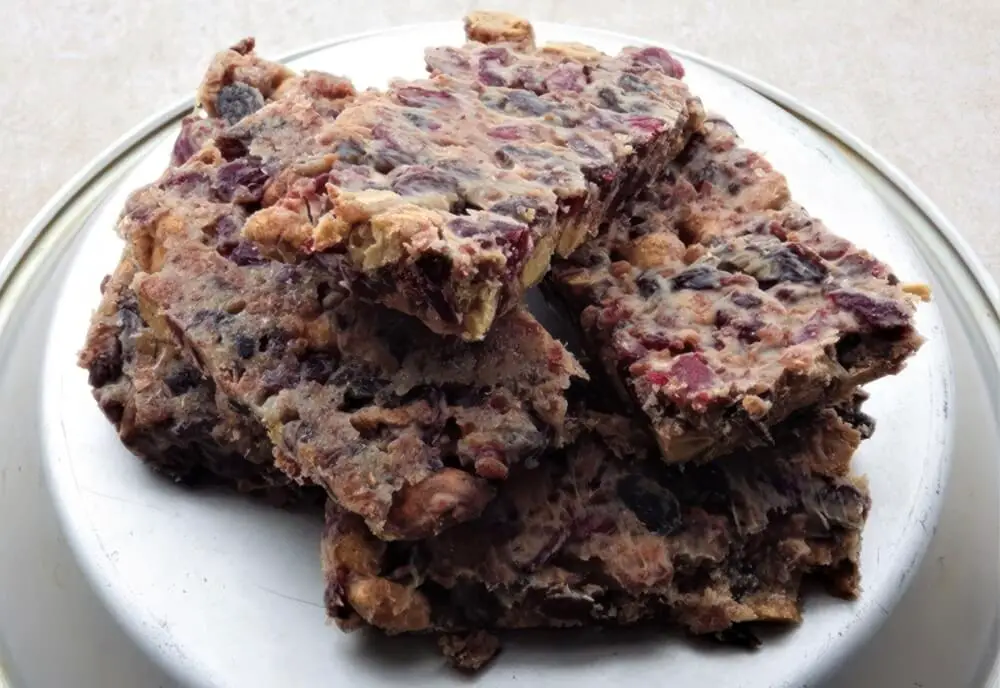
Prep Time: 30 minutes
Cook Time: 1 hour
Total Time: 1 hour 30 minutes
Yield: Approximately 2 pounds
Ingredients
- 2 pounds of bacon
- 1 pound of suet or beef tallow (beef fat)
- ¼ pound (4 ounces) of jerky
- 1 cup of raisins
- 1 cup of craisins (dried cranberries)
- 1 cup of peanuts
- ¼ cup of honey
- 1 teaspoon of kosher salt
Instructions
Render the Fat:
- In a large skillet, cook the bacon over medium heat until crispy. Remove the bacon and set aside.
- Add the suet or beef tallow to the skillet and render it down until it becomes liquid.
- Once rendered, remove any solid bits and set the liquid fat aside.
Fry the Jerky:
- In the same skillet with the rendered fat, add the jerky pieces.
- Fry until they become crispy. Remove and set aside.
Process Meats:
- Once cooled, place the crispy bacon and jerky into a food processor.
- Pulse until they are finely chopped into small bits.
Combine Dry Ingredients:
- In a large mixing bowl, combine the processed meats, raisins, craisins, peanuts, and kosher salt.
- Mix well to ensure even distribution.
Add Honey and Fat:
- Drizzle the honey over the mixture.
- Gradually pour in the rendered fat, stirring continuously until all ingredients are thoroughly coated and the mixture holds together.
Form and Cool:
- Transfer the mixture into a parchment-lined baking dish or mold. Press down firmly to compact the mixture.
- Allow it to cool at room temperature until it solidifies.
Perpetual Soup
Perpetual soup is a traditional method of keeping a pot of broth simmering continuously by regularly adding water, bones, and vegetables. Popular among pioneers and homesteaders, it provided a steady supply of nutritious, flavorful soup that could feed a family for days—or even weeks—with minimal waste.

Ingredients
- Water: Use pure, spring water; avoid well or tap water due to potential off-flavors.
- Bones: Beef, pork, or poultry carcasses. Roast raw bones at 350°F for 30–45 minutes to enhance flavor.
- Vegetables: Choose from onions, carrots, celery, parsnips, rutabagas, kale, spinach, and green onions.
- Seasonings: Salt, pepper, bay leaves, herbs like basil or thyme, and leafy greens such as dandelion greens or plantain leaves.
- Apple Cider Vinegar: Optional; a tablespoon helps extract minerals from bones.
Instructions
- Fill the Crockpot: Add water until the pot is two-thirds full.
- Add Ingredients: Place roasted bones and chosen vegetables into the water.
- Initial Cooking: Cover and set the crockpot to high until the soup reaches a boil. Then reduce to low and simmer overnight (12–24 hours).
- Morning Routine:
- Taste and adjust seasonings as desired.
- Remove and discard bones.
- Set the crockpot to warm and serve as needed.
- Daily Maintenance:
- Replenish with additional water, bones, and vegetables.
- Bring to a boil on high for 15 minutes.
- Adjust seasonings and return to warm setting.
- Serving Options:
- For a clear broth, strain through cheesecloth.
- To enjoy as a hearty soup, remove bones and serve with the vegetables.
- Cooked pasta or rice can be added to individual servings.
You can view pictures of the process here.
Pinole
Pinole is an ancient Meso-American recipe made from toasted cornmeal, sweetener, and spices. Traditionally used by Indigenous peoples for energy and nourishment, it's now making a comeback in smoothies, cereals, and even baked goods.
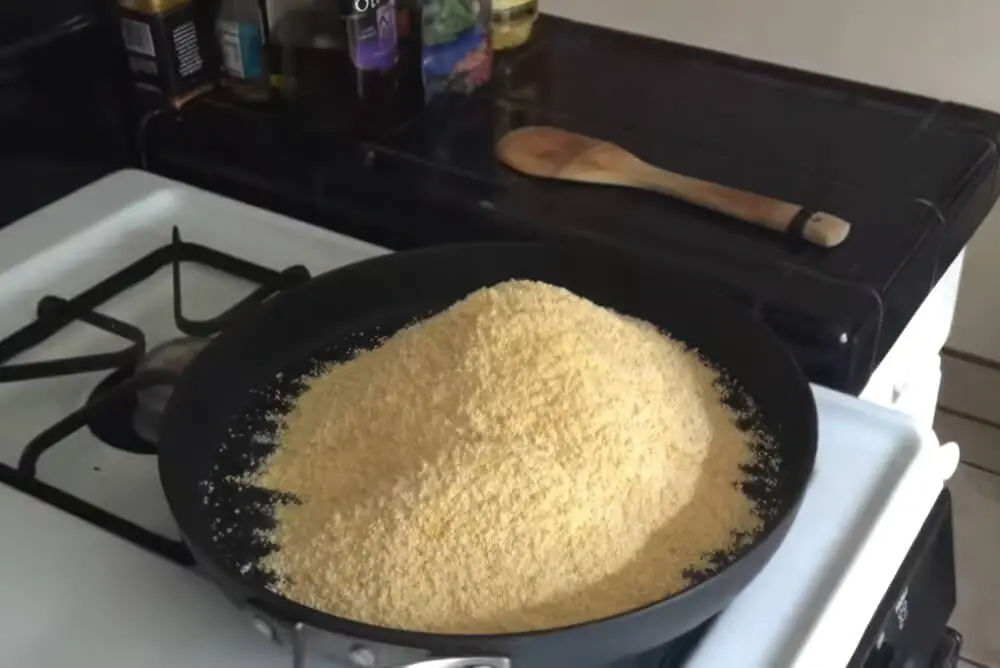
Ingredients
- 24 oz organic cornmeal
- 6 tablespoons turbinado raw cane sugar (or sweetener of choice)
- 2 tablespoons ground Mexican Ceylon cinnamon
Instructions
- Toast the Cornmeal: Heat a dry skillet or pan over low to medium-low heat. Add the cornmeal and toast it for about 10 minutes, stirring frequently, until it becomes golden brown and aromatic. Be sure not to let it burn.
- Cool Slightly: Let the toasted cornmeal cool for a few minutes off the heat.
- Blend: Add the toasted cornmeal, sugar, and cinnamon to a blender or food processor. Blend until it forms a fine, uniform powder.
- Use or Store: Store in an airtight container. Use in smoothies, as a hot cereal with nut milk and fruit, or mix into baked goods.
Potato Cakes
Pioneer potato cakes were a staple in 1800s frontier cooking because they're such a great way to use up leftover potatoes. They were often cooked on cast iron over open fires or wood stoves and served at breakfast.

Prep Time: 15 minutes
Cook Time: 15 minutes
Servings: 8
Ingredients
- 6 medium potatoes
- 2 teaspoons salt
- ½ cup milk
- 2 eggs
- 1 cup all-purpose flour
- Shortening or canola oil for frying
- Cornstarch (optional, for thickening)
Instructions
- Prepare the Potatoes: Wash the potatoes thoroughly. You may peel them or leave the skins on for added nutrients. Remove any eyes or blemishes.
- Preheat the Skillet: Place a cast iron skillet over low heat and add enough shortening or oil to cover the bottom (about ¼ inch deep). Allow it to warm up slowly.
- Grate the Potatoes: Using a grater or mandoline, finely grate the potatoes into a large mixing bowl.
- Mix the Batter: To the grated potatoes, add salt, milk, eggs, and flour. Stir until well combined. If the mixture appears too runny, add a bit more flour or a tablespoon of cornstarch to thicken.
- Increase Heat: Raise the skillet's heat to medium-high, allowing the oil to reach frying temperature.
- Fry the Cakes: Carefully spoon portions of the potato mixture into the hot oil, forming medium-sized pancakes. Fry until the bottom is golden brown, then flip and cook the other side until equally browned.
- Drain and Serve: Remove the cooked potato cakes from the skillet and place them on paper towels to drain excess oil. Serve warm, optionally topped with syrup, powdered sugar, or your favorite savory toppings.
Sally Lunn Bread
Sally Lunn bread is a soft, rich bun with origins in 18th-century England, but it got very popular in 1800s America for its texture and slightly sweet flavor. It straddles the line between bread and cake and goes great with tea or breakfast.
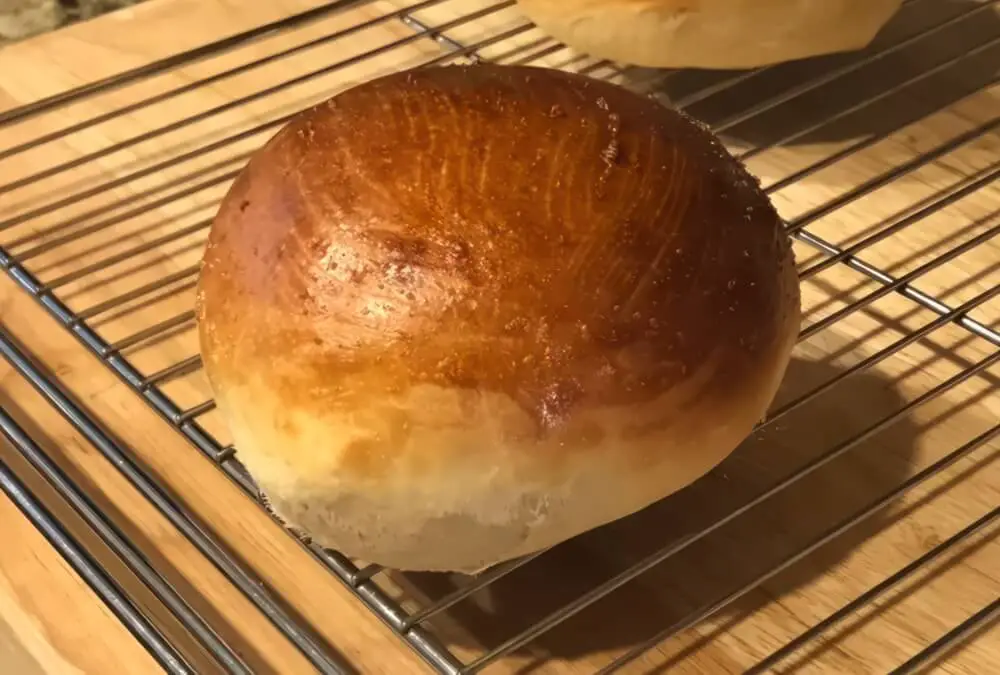
Ingredients
- 1¼ cups (280 ml) whole milk
- 6 tablespoons (85 g) butter, room temperature
- ¼ cup (50 g) sugar
- 3¾ cups (450 g) bread flour (or all-purpose flour)
- 7 g instant yeast or active dry yeast
- 2 eggs (plus 1 egg for egg wash)
- Zest of 1 lemon
- 1½ teaspoons salt
- 2–3 saffron threads (optional, for color)
Instructions
- Warm Milk Mixture: Gently heat the milk and dissolve in the sugar. Add the butter to melt. If using saffron, add threads now. Let mixture cool to 110°F.
- If using instant yeast, heat the full milk amount.
- If using active dry yeast, heat 1 cup; use the remaining ¼ cup to activate yeast with a sprinkle of sugar.
- Mix Dry Ingredients: Sift flour into a large bowl or stand mixer. Whisk in instant yeast if using.
- Combine Ingredients: Remove saffron threads (if used), then add milk mixture to the flour. Mix in lemon zest, eggs, and salt.
- If using active yeast, add that mixture last.
Knead on medium speed about 8 minutes until a sticky dough forms (it won’t form a firm ball).
- If using active yeast, add that mixture last.
- First Rise: Cover the bowl and let dough rise in a warm place for 60–90 minutes, until doubled in size.
- Shape the Dough: Punch down dough, turn onto a lightly floured surface, and divide into 3–6 equal parts. Shape into balls and place on a lined baking sheet, gently flattening into disks. Cover and let rise again for 45–60 minutes.
- Preheat oven to 400°F.
- Make an egg wash using a whole egg or just the white (especially if saffron was used).
- Bake for 15 minutes. Tent with foil if browning too quickly. Bread is done when the internal temperature reaches 190–200°F. Cool on a wire rack. Serve warm with butter, jam, or clotted cream.
This modern adaptation was inspired by Tasting History with Max Miller
Shoofly Pie
Shoofly Pie is a classic Pennsylvania Dutch dessert that got popular in the late 1800s. Its name is believed to have originated from a brand of molasses called “Shoo-Fly Molasses,” which are used in the recipe. The rich flavor and crumbly topping made it a favorite among pioneers since it could easily be made with pantry staples.
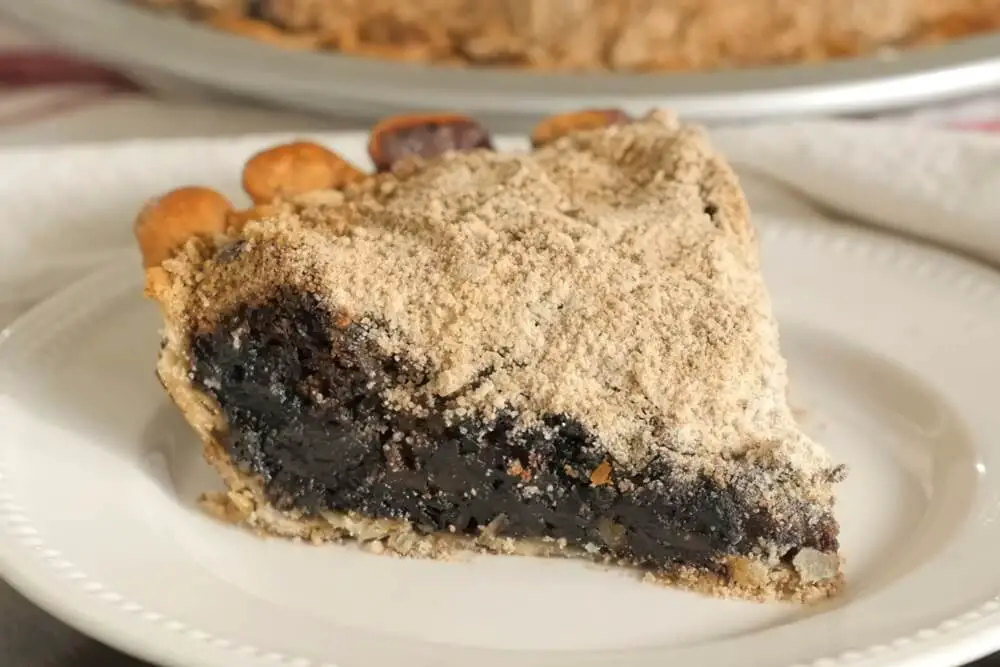
Ingredients
- 1 unbaked 9-inch pie crust (homemade or store-bought)
For the filling:
- 1 cup molasses
- ¾ cup hot water
- 1 large egg, beaten
- ¾ teaspoon baking soda
For the crumb topping:
- 1½ cups all-purpose flour
- ½ cup brown sugar
- ¼ cup granulated sugar
- ½ teaspoon ground cinnamon
- ¼ teaspoon ground nutmeg
- ¼ teaspoon salt
- ¼ cup unsalted butter, cold and cut into small pieces
Instructions
- Preheat oven to 400°F.
- Prepare the filling: In a medium bowl, combine molasses and hot water. Stir in the beaten egg and baking soda until well mixed.
- Prepare the crumb topping: In a separate bowl, whisk together flour, brown sugar, granulated sugar, cinnamon, nutmeg, and salt. Cut in the cold butter using a pastry cutter or your fingers until the mixture resembles coarse crumbs.
- Assemble the pie: Pour the molasses filling into the unbaked pie crust. Sprinkle the crumb topping evenly over the filling.
- Bake: Place the pie on the center rack of the preheated oven and bake for 15 minutes. Then, reduce the oven temperature to 350°F and continue baking for an additional 20–25 minutes, or until the filling is set and the topping is golden brown.
- Cool: Allow the pie to cool completely on a wire rack before serving.
Switchel
Switchel, also known as “haymaker’s punch,” was very popular in the 1700s and 1800s among farmers and sailors, partly because of its ability to rehydrate you and give you an energy boost while working on a hot day.
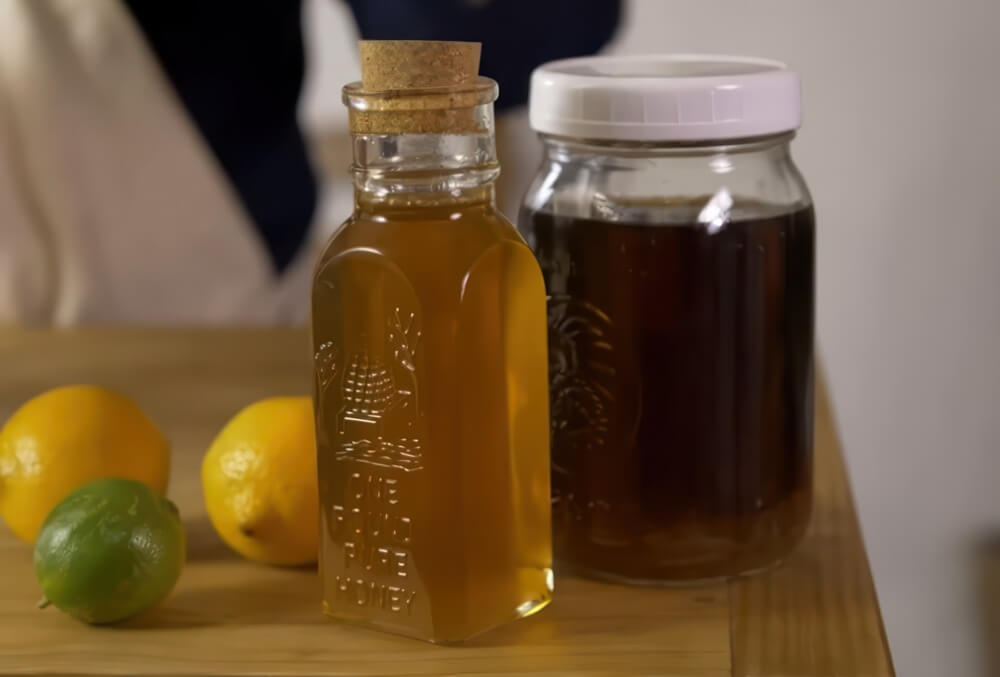
Ingredients
- ½ gallon clean drinking water
- ½ cup unsulphured molasses (Barbados or light molasses)
- ¼ cup apple cider vinegar
- 1 heaping tablespoon powdered ginger
Optional Substitutions:
- Maple syrup or honey instead of molasses
- Lemon or lime juice instead of (or in addition to) vinegar
- Fresh minced ginger instead of powdered ginger
- A splash of rum for a historical twist
Instructions
- Combine Ingredients: In a large pitcher or jug, combine the water, molasses, vinegar, and powdered ginger.
- Stir Thoroughly: Mix well until the molasses is fully dissolved and the ingredients are evenly combined.
- Chill or Serve: Serve immediately at room temperature, or chill in a fridge, well, or stream for a refreshing drink. Stir again before serving if settled.
Thomas Jefferson's Macaroni and Cheese
Thomas Jefferson is credited with helping popularize macaroni and cheese in America after encountering it in Europe. He brought back pasta and Parmesan from Italy and served a baked version of mac and cheese at a White House state dinner in 1802.
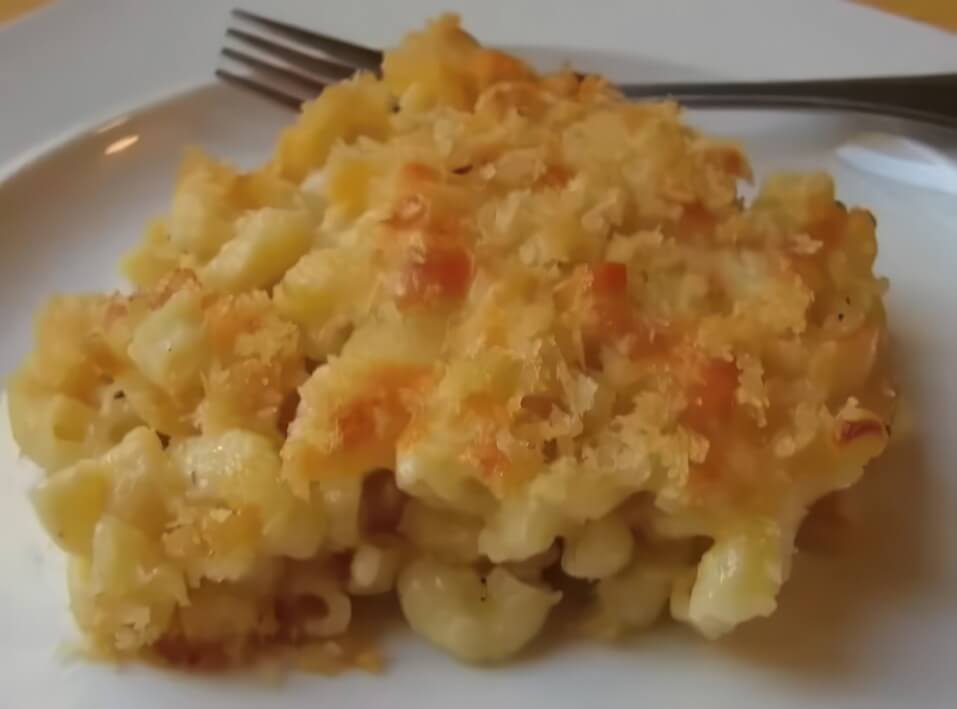
Ingredients
For the cheese sauce:
- 3 tablespoons butter
- 3 tablespoons all-purpose flour
- 1 teaspoon Dijon mustard
- ¼ teaspoon thyme
- Pinch of cayenne pepper
- Pinch of white pepper
- Freshly grated nutmeg (to taste)
- 3 cups whole milk (1 cup cold to start, then 2 cups warm)
- 3 cups shredded cheese (recommended: a mix of cheddar, gouda, and Gruyère; or all sharp cheddar)
- 2–3 drops Worcestershire sauce
- Salt, to taste
For assembly:
- 8 to 16 oz elbow macaroni (adjust based on how cheesy you want it; 8 oz = creamy, 16 oz = lighter)
- ¾ cup reserved shredded cheese (for topping)
- ½ cup panko breadcrumbs
- 1 tablespoon butter (melted, for topping)
Instructions
- Make the Roux: Melt butter in a saucepan over medium heat. When it foams, whisk in flour to form a roux. Cook for 3–4 minutes to remove the raw flour taste.
- Flavor the Roux: Stir in thyme, cayenne, white pepper, and a few grates of fresh nutmeg. Cook for 1 minute more.
- Add Milk: Whisk in 1 cup of cold milk (to avoid lumps), then add remaining 2 cups of warm milk. Stir constantly as the sauce thickens over medium heat.
- Season the Sauce: Add Worcestershire sauce and a teaspoon of salt. Simmer gently for 8 minutes.
- Melt the Cheese: Turn off the heat. Gradually stir in the cheese in batches, saving ¾ cup for topping. Stir until smooth. Mix in Dijon mustard.
- Cook the Pasta: Boil macaroni to al dente. Drain well.
- Assemble: In a baking dish, combine pasta and cheese sauce. Top with reserved shredded cheese.
- Add Crust: Mix panko breadcrumbs with melted butter and sprinkle over the top.
- Bake at 400°F for about 20 minutes, or until the top is golden brown. Let cool slightly before serving.
Like this post? Don't Forget to Pin It On Pinterest!
You May Also Like:
The post 18 Vintage Recipes From The 1800s appeared first on Homestead Survival Site.
from Homestead Survival Site https://ift.tt/OU5xsMS
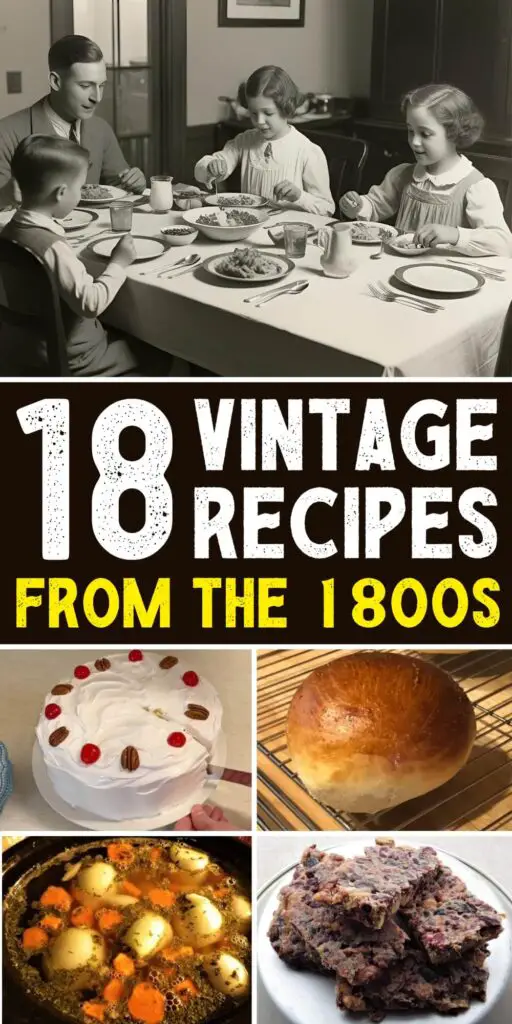
No comments:
Post a Comment